NASA and Matt Damon Told Us Why The Martian Is "a Love Letter to Science"
Right now, here’s how close we are to the events of Andy Weir’s novel The Martian actually happening: Not very. NASA believes we’re probably about 20 years away from putting an astronaut on Mars, but as the movie about a astronaut being stranded on Mars hits theaters, 20 years feels longer than it sounds.
This week, io9 was among a group of journalists who were not only shown the first 49 minutes of The Martian, which opens October 2, we were taken to NASA’s Jet Propulsion Laboratory outside of Pasadena, CA to find out more about the reality of putting an astronaut on Mars. As you probably remember, in 2012, NASA landed JPL’s uncrewed Curiosity Rover on the surface of the red planet. Three years later, they’re currently trying to figure out how to land a probe two times that size on the surface. Tests are being designed, and held, figuring out a way to get a probe that size to slow down enough so it wouldn’t crash on the planet surface.
Over 50 years of space exploration, NASA has landed seven crafts on the surfaces of Mars. That’s only about half of the attempts—which means that projects that cost hundreds of millions of dollars have either failed to launch, got lost when they arrived on Mars, or any number of other failures. Landing on Mars is not something that anyone takes for granted, even decades later.
In The Martian, not only does a team of astronauts land on Mars, they have a way to leave, and that means a craft much bigger than Curiosity. Nothing that’s ever landed on Mars has been able to leave. Coming home would require rockets, and rockets, in turn, would mean the probe landing on Mars would need to be much heavier and bigger. And to land something much heavier and bigger on Mars, you have to figure out how to slow it down. And to slow it down, you need a parachute. Which is exactly what the men and women of JPL are currently testing.They’re trying to build a parachute, out of nylon and kevlar, that can slow down an object double the size of what they sent last time. They’ve done multiple tests, but none of them have been successful yet. And once the parachute test is successful, then a whole other set of problems opens up.
All of that adds up to one thing: Real science is pretty far away from the science fiction of The Martian, but that doesn’t mean this story isn’t valuable. “”Science fiction is extremely important in our culture,” said Dr. Jim Green, the head of Planetary Exploration at NASA. “It’s ingrained in what we do, but it really projects a vision of the future. Something that we aspire to. What I really enjoyed about the book and movie is how close to reality it can be. It’s just around the corner for us.”
In The Martian—the movie version of which is directed by the man behind Blade Runner andAlien, Ridley Scott—an American astronaut is stranded on Mars. His struggle, as well as the world’s concern for him, shine a light on what makes humanity great. Having watched the first 49 minutes of the film, “humanity” is definitely the first word that comes to mind. Scott’s obviously a master of futuristic action, and The Martian has some of that. But despite what that spoiler-filled new trailer looks like, it’s a much more grounded story, at least at the beginning. There are more shots of Matt Damon’s stranded astronaut Mark Watney joking into the camera than there are explosions. A gruesome self-surgery, a bit of disco dancing, or a literal pile of shit are the biggest set pieces. The Martian is a story based on science and very focused on problem-solving, and that makes this epic Hollywood blockbuster feel incredibly personal. Which is a rarity in a science fiction film, especially.
“What [NASA’s] done in the last 50 years is quite extraordinary, and I hope the film does it justice,” Scott told us. That symmetry was obviously the aim from the beginning. The story originated in the mind of Andy Weir (pictured below, second from right), a computer programmer who originally posted chapters of this meticulously researched story on his website. Those became an eBook, which was picked up by a major publisher, and Fox bought the film rights soon after. Screenwriter Drew Goddard (The Cabin in the Woods, Daredevil) was then tasked with adapting the book, and had a very specific aim in mind.
“The first thing [Goddard] said was ‘I want this to be a love letter to science,’” said Matt Damon. “We had a long conversation about that and how that’s a really wonderful thing to put out into the world right now. And I don’t have any lofty expectations but I hope some kids see it and geek out on the science, enjoy it, and maybe it’s one thing in their life that pushes them in that direction.”
The fact a group of journalists was not only shown such a big chunk of the film, but brought to JPL, is a good sign everyone got it right. “[The Martian] is a fairly reasonable representation of challenges that we’ll be seeing in the future,” said Charles Elachi, director of JPL. The book is also now required reading for anyone working at the Johnson Space Center in Houston, Texas, according to Green (above, far right). He was the first person at NASA to get involved with the film, when Ridley Scott called them and asked for a meeting. Their first conversation lasted for 90 minutes. “I answered at least 20 or 30 questions and there were 20 or 30 questions that I couldn’t answer, but I knew who could answer them,” Green said.
The planetary exploration expert was even asked to give notes on the script. One example relates to the crux to the whole movie. In The Martian, Watney is stranded when he’s hit with debris during a violent dust storm on Mars. His monitor is broken, he’s presumed dead, and his team leaves. However, Green explained that Mars’ planetary conditions don’t allow dust storms to get violent enough for that kind of destruction. Since the novel was published, though, NASA has learned some Martian storms do get upwards of 30km high and can include powerful fits of lightning. Green suggested, if the film wanted to be more scientifically accurate, lightning could cause the debris.
In the finished film, the filmmakers did put some lightning into the background of the scene, but Watney’s separation from the group still happens unscientifically, when he’s hit with a broken satellite. “It’s a movie,” said Green. “For my science friends, I say ‘Check the science at the door, go in and have a great time.’”
However, that disconnect between science and movies is part of the reason why NASA can sometimes have trouble connecting with people. The employees there are doing amazing things. Amazing things that could, potentially, save our planet. But those things are expensive (each one of the aforementioned parachute tests cost $20-30 million each. The probes themselves, multiple billions) and NASA’s people are so good at what they do, so detailed in their preparation, that the kind of tragedy dramatized in The Martian almost never happens.
“The challenge we have at NASA is part of our job is to go out and educate the public, talk to kids, inspire people, but unfortunately we do that with the boring things we do really well,” said astronaut Drew Feustel, above left. “We’ve been exploring space for a long long time with humans. The challenge we have is we do it well, we do it right, and we kind of make no mistakes. We try to keep the drama out of it. For entertainment, that’s what makes movies great. But as an astronaut, the last thing we want to happen is something to go wrong. That’s not part of our business. And it’s great that we have the help of Hollywood with these movies and we hope we can combine the arts and science and keep that momentum going. We’ve been doing the best job we can, we just don’t do it as dramatic as we should, but that’s the good side. That’s the way we’re successful.”
And that’s why NASA is embracing something like The Martian. It may be straight up science fiction, but it’s as based in science as it can be. It shows something that could potentially happen in our lifetime and it does that with a sense of Hollywood flare that gets people to notice.
Here are some highlights from the Q&A featuring Feustel, Damon, Scott, Weir and Green:
Contact the author at [email protected]. Images: Top three, courtesy of 20th Century Fox. Bottom two, Eric Charbonneau/Le Studio Photography

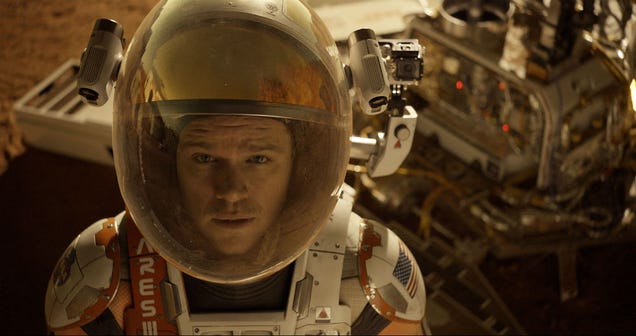
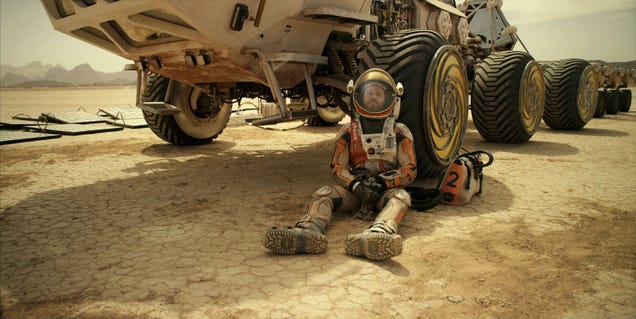
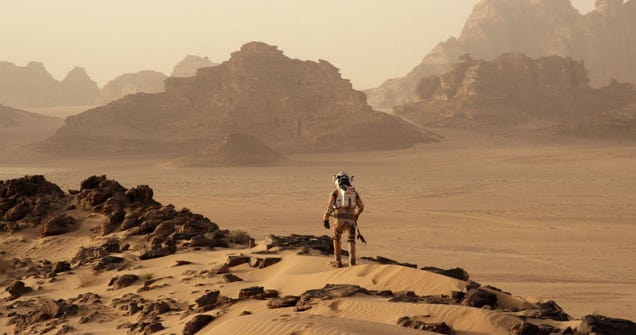
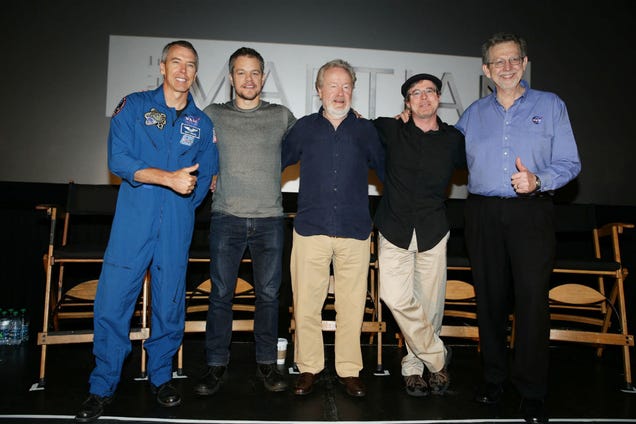
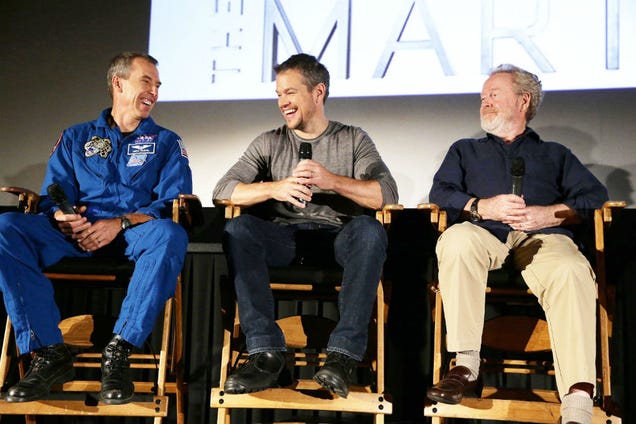
Comments
Post a Comment